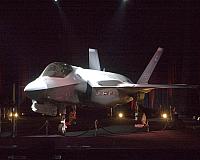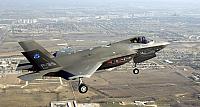Fighter Jet News
F-35 Lightning II News
Lockheed plans F-35 JSF flight test changes
September 17, 2007 (by
Asif Shamim) -
Flight International reported that Lockheed Martin is looking at iniatives to keep the Joint Strike fighter programme on budget and on track at the mid-point of its development.
Some of things being considered include:
Global supply chain for production and sustainment.
Reducing the number of flight test aircraft from 18 to 16 and more reliance on laboratories and flying testbeds.
Coalition purchase partnership to fix airframe costs
The changes have come about due to the "mid-course review" which is reached the half way point of the 12 year development programme. Lockheed Martins, Dan Crowley, executive vice-president and F-35 programme general manager gave the following quote "Our ability to define a verification plan is much greater than it was six years ago," and went on to say "We are accountable for managing the resources responsibly if we can see a better way to finish the programme."
The reduction of Flight test has been cleared by all three services and is waiting on final approval from the undersecretary of defence for acquisitions John Young.
The F-35 is being developed in three variants, but the mission system is 98% common. "We are holding to the original value proposition of developing three aircraft for the price of two," says Crowley. "But testing on one variant reduces risk on the others. We do not need three times the flight test and ground test."
Further plans include shifting more mission-system testing to the Cooperative Avionics Testbed, or CATBird, a modified Boeing 737-300 which tests the F-35's sensors and avionics. The 737 is in final installation and is due to begin flight-testing of the communication/navigation/identification and electronic warfare systems by year-end.
The integrated laboratories at Lockheed Fort Worth site will be utilised to test mission system flight testing. A factor which was missing when testing the Lockheed F-22 resulting in problems which beset flight testing due to hardware and software issues.
"We need lots of flight-test assets for flight sciences, because of the differences between the variants and their flight profiles," Crowley said. "But the laboratories bring a big payoff in less reliance on mission system flight testing to demonstrate maturity." The JSF laboratories are also discovering problems earlier. "Flight testing is the last and most expensive way to find and retire risk," he says.
Further factors being looked at include coalition purchase buys similar to the original partnership which was formed for the sale of almost 700 F-16s by European nations. This new coalition would combine US and foreign sales for seven years between 2012 to 2018 resulting in a fixed price for upto more than 1300 airframes.
The economics of such a deal would reduce the likelyhood of early purchases, but would require the US government to commit by 2012, almost two years earlier than planned and before the F-35 had finished operational testing.
The changes have come about due to the "mid-course review" which is reached the half way point of the 12 year development programme. Lockheed Martins, Dan Crowley, executive vice-president and F-35 programme general manager gave the following quote "Our ability to define a verification plan is much greater than it was six years ago," and went on to say "We are accountable for managing the resources responsibly if we can see a better way to finish the programme."
The reduction of Flight test has been cleared by all three services and is waiting on final approval from the undersecretary of defence for acquisitions John Young.
The F-35 is being developed in three variants, but the mission system is 98% common. "We are holding to the original value proposition of developing three aircraft for the price of two," says Crowley. "But testing on one variant reduces risk on the others. We do not need three times the flight test and ground test."
Further plans include shifting more mission-system testing to the Cooperative Avionics Testbed, or CATBird, a modified Boeing 737-300 which tests the F-35's sensors and avionics. The 737 is in final installation and is due to begin flight-testing of the communication/navigation/identification and electronic warfare systems by year-end.
The integrated laboratories at Lockheed Fort Worth site will be utilised to test mission system flight testing. A factor which was missing when testing the Lockheed F-22 resulting in problems which beset flight testing due to hardware and software issues.
"We need lots of flight-test assets for flight sciences, because of the differences between the variants and their flight profiles," Crowley said. "But the laboratories bring a big payoff in less reliance on mission system flight testing to demonstrate maturity." The JSF laboratories are also discovering problems earlier. "Flight testing is the last and most expensive way to find and retire risk," he says.
Further factors being looked at include coalition purchase buys similar to the original partnership which was formed for the sale of almost 700 F-16s by European nations. This new coalition would combine US and foreign sales for seven years between 2012 to 2018 resulting in a fixed price for upto more than 1300 airframes.
The economics of such a deal would reduce the likelyhood of early purchases, but would require the US government to commit by 2012, almost two years earlier than planned and before the F-35 had finished operational testing.
Related articles:
Forum discussion:
Tags
- More funding for F-35 production ( 2007-07-25)
- F-35 Lightning II pushing ahead on all fronts ( 2007-06-20)
- First round of funding for F-35 JSF released ( 2007-04-21)
- F-35 JSF avionics test bed arrives at Edwards ( 2007-03-08)
- Six additional countries consider joining JSF ( 2006-10-30)
- F-35 Lightning II news archive
Forum discussion:
- Start a discussion about this article in the F-35 forum.
Tags



